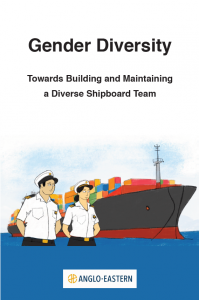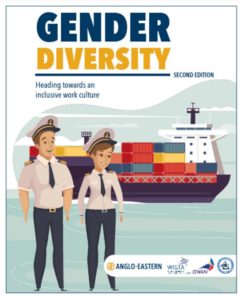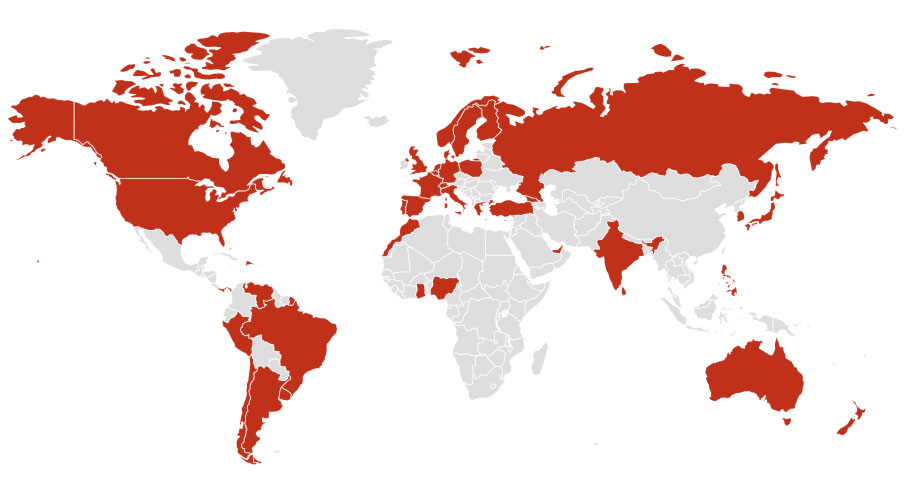The Diversity Handbook
WISTA International, Anglo Eastern, International Seafarers Welfare and Assistance Network (ISWAN) and International Chamber of Shipping (ICS) conducted a public online survey designed to examine how female seafarers perceived “discrimination” and how it manifested onboard based on their personal experiences. The complete findings from the survey and recommendations are published in The Diversity Handbook.
Highlights from the Gender Diversity Report
-
1128 women seafarers from 78 countries
-
60% of women reported encountering gender-based discrimination onboard
-
66% of the respondents concur that their male employees had turned to harassing and intimidating female co-workers
-
25% reported that in the shipping sector, physical and sexual harassment is common, occurring on board and involving intrusions on their privacy
The first handbook on gender diversity’s launch in January 2018 received an impressive response to its survey. The recent one, also initiated by Sanjam Sahi Gupta, Founder of WISTA India and a WISTA International Executive Committee member from 2014-2021 – was completed by 1128 women from 78 countries. The Philippines (399) had the largest proportion, followed by the United States (98), the United Kingdom (57), South Africa (51), Brazil (47), India (41), Peru (36), Columbia (35) and Indonesia (35).
The majority of respondents, approximately 90%, work on cruise ships, with the remainder employed on cargo ships, gas and oil tankers, container ships (>8000 TEU), general cargo/geared vessels, chemical tankers, bulk carriers and tugs.
The survey also made it possible to collect data on company harassment and bullying policies, company and industry hotlines and the effect of the pandemic on women’s experiences at sea and provided insights into how businesses may operate in the sector to promote gender diversity and dispel prejudice.
Presence of Discrimination Onboard
The majority of respondents – 60% – reported encountering gender-based discrimination onboard, while just 40% of respondents said there was no such discrimination.
34% of the respondents acknowledged feeling alienated or neglected due to their gender, while 29% of the respondents had encountered harassment and bullying on board. A resounding 66% of the women seafarers concur that their male employees had turned to harassing and intimidating female co-workers.
Offensive Approaches via several media
13% of the surveyed seafarers have mentioned that they have been offensively approached via different media, while a majority 70% of these women seafarers claim that it was their male colleagues who perpetrated such offensive harassment onboard.
Onboard harassment with personal questions and other ways of intruding on privacy
25% of the respondents admitted to having encountered onboard harassment, including being approached with personal questions, overly familiar remarks or being invited to meet in the cabin on a private basis. This indicates a widespread issue with onboard harassment when the victim is subjected to numerous threats. The statistics show that the vast majority of those engaging in such crimes are male seafarers (88%), while other instances (11%) involve both men and women co-workers, and only about 1% involve women.
Uncomfortable Persuasion, Indecent Remarks and Body Shaming
In the shipping sector, physical and sexual harassment is common. According to 25% of respondents, it occurred on board and involved intrusions on their privacy, such as uncomfortable persuasion, inappropriate remarks and body shaming. Once more, an overwhelming 90% of those involved were male co-workers, while 8% were male and female and only 2% were female seafarers.
Harassment and Bullying Policy
97% of respondents agreed that the company had a harassment and bullying policy, though nearly 60% of the respondents acknowledged having experienced harassment. Therefore, organisations must ensure that their Company Harassment Policies are extensively publicised to increase their visibility, level of awareness, and stringent on-the-ground enforcement.
80% of the female seafarers reported that their immediate superiors had spoken with them about the company’s anti-harassment policy. Again, it is important to note that 60% of these acknowledged experiencing harassment while on board and admitted that they were unsure of what to do in such circumstances.
Incidence of Reporting Discriminatory Behaviour
Although 73% of the respondents felt comfortable escalating their concerns to their senior officers, only 13% reported such incidents to their superiors, while only 7% were satisfied with the outcomes. 59% of all the respondents have faced gender-based discrimination, while 66% felt ignored.
Regarding helplines, only 13% of respondents reported the harassment they had experienced. The efficiency of these helplines, their availability at all times and how the concerns of the seafarers are addressed at the source must all be seriously addressed.
Regarding the opportunities for training, although 82% of women seafarers agreed that they had received instruction on adapting to the ship’s environment, this percentage has to be far higher, given how vital adaptability to the ship’s environment is.
1st Edition of The Diversity Handbook 2018
Gender Diversity Manual
Click the image below to download the Gender Diversity Manual – produced in conjunction with Anglo-Eastern and ISWAN .
2nd Edition of The Diversity Handbook 2022
Click the image below to download the Gender Diversity Booklet – produced in conjunction with Anglo-Eastern and ISWAN.





